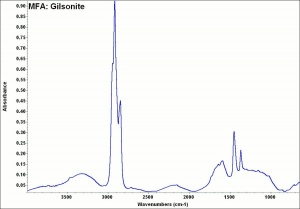Difference between revisions of "Gilsonite"
(username removed) |
|||
| Line 1: | Line 1: | ||
== Description == | == Description == | ||
| − | [American Gilsonite Co] A registered trademark for a very pure, rock-hard, [ | + | [American Gilsonite Co] A registered trademark for a very pure, rock-hard, [[asphalt]] originally sold in the late 19th century. Gilsonite®, or uintahite, is a natural [[bitumen]] found only in the Uinta Mountains of Utah. It is very brittle and lustrous. Gilsonite® is used in black varnishes, lacquers, baking enamels, japans, [[linoleum]], floor tile and paving where it increases resistance to acids, alkalis and water. In the early 19th century, Gilsonite® was often mixed with [[mica]], [[asbestos]], gums, or resins to produce electrical components. It is also the first solid hydrocarbon to be converted to [[gasoline]]. |
== Synonyms and Related Terms == | == Synonyms and Related Terms == | ||
Revision as of 09:14, 16 January 2014
Description
[American Gilsonite Co] A registered trademark for a very pure, rock-hard, Asphalt originally sold in the late 19th century. Gilsonite®, or uintahite, is a natural Bitumen found only in the Uinta Mountains of Utah. It is very brittle and lustrous. Gilsonite® is used in black varnishes, lacquers, baking enamels, japans, Linoleum, floor tile and paving where it increases resistance to acids, alkalis and water. In the early 19th century, Gilsonite® was often mixed with Mica, Asbestos, gums, or resins to produce electrical components. It is also the first solid hydrocarbon to be converted to Gasoline.
Synonyms and Related Terms
uintaite; gilsonita (Esp.); asfaltita (Esp.); uintahite; Gilsonite; asphaltite; Utah coal resin; rock asphalt
Other Properties
Soluble in ethanol, turpentine, mineral spirits.
Softening point = 290-400F. Acid value = 2.3
| Density | 1.04-1.10 |
|---|
Hazards and Safety
Skin contact may cause irritation.
Additional Information
American Gilsonite Co.: Website
Authority
- Ralph Mayer, A Dictionary of Art Terms and Techniques, Harper and Row Publishers, New York, 1969 (also 1945 printing)
- Richard S. Lewis, Hawley's Condensed Chemical Dictionary, Van Nostrand Reinhold, New York, 10th ed., 1993
- The Merck Index, Martha Windholz (ed.), Merck Research Labs, Rahway NJ, 10th edition, 1983 Comment: entry 9977
- Wikipedia, the free encyclopedia, at http://www.wikipedia.com Comment: http://en.wikipedia.org/wiki/Gilsonite (Accessed Jan. 15, 2006)
- Random House, Webster's Encyclopedic Unabridged Dictionary of the English Language, Grammercy Book, New York, 1997
- The American Heritage Dictionary or Encarta, via Microsoft Bookshelf 98, Microsoft Corp., 1998
- Art and Architecture Thesaurus Online, http://www.getty.edu/research/tools/vocabulary/aat/, J. Paul Getty Trust, Los Angeles, 2000
